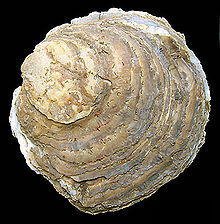- Ostrea edulis
-
Ostrea edulis 
Ostrea edulis – exterior of "left" valve Scientific classification Kingdom: Animalia Superphylum: Lophotrochozoa Phylum: Mollusca Class: Bivalvia Subclass: Pteriomorphia Order: Ostreoida Suborder: Ostreina Superfamily: Ostreoidea Family: Ostreidae Genus: Ostrea Species: O. edulis Binomial name Ostrea edulis
Linnaeus, 1758[1][2] 'Belons' from Cancale, Brittany
'Belons' from Cancale, Brittany
Ostrea edulis is a species of oyster native to Europe and commonly known as the European flat oyster, Colchester native oyster, mud oyster, or edible oyster (despite this latter name it is not the only oyster that is edible by humans). When mature O. edulis adults range from 3.8 to 11 centimetres (1.5 to 4.3 in) across.[3] The species naturally ranges along the western and southern coasts of Europe from Norway to Morocco and including most of the British Isles and the Mediterranean coast.[4] Naturally viable populations have appeared in eastern North America from Maine to Rhode Island subsequent to artificial introduction in the 1940s and 1950s.[4]
Ostrea edulis is now also being maricultured in the states of California, Maine, and Washington in the United States. The species once dominated European oyster production but disease, pollution, and overfishing sharply reduced the harvest.[4] Today Pacific oysters, Crassostrea gigas, account for more than 75 percent of Europe’s oyster production.
U.S. oyster growers farm O. edulis in small quantities on both coasts. They are prized for their unique tannic seawater flavor, sometimes described as dry and metallic, and are more expensive than other American oysters.[4] The flavor is considered excellent for eating raw on the half shell.[5][6] In France the species has an AOC classification - only oysters harvested from the Bélon River in Brittany can be called Bélon oysters (French: Huîtres de Bélon.[citation needed]
See also
References
- ^ Linnaeus, Carl (1758) (in Latin). Systema Naturae (10 ed.). Uppsala: Linnaeus.
- ^ "ITIS Standard Report Page: Ostrea edulis". http://www.itis.gov/servlet/SingleRpt/SingleRpt?search_topic=all&search_value=Ostrea+edulis&search_kingdom=every&search_span=exactly_for&categories=All&source=html&search_credRating=All. Retrieved 2008-08-06.
- ^ Jackson, Angus (2008-07-14). "Basic information for Ostrea edulis (Native oyster)". Plymouth: Marine Biological Association of the United Kingdom. http://www.marlin.ac.uk/species/Ostreaedulis.htm. Retrieved 2008-08-07.
- ^ a b c d "FAO Fisheries & Aquaculture Ostrea edulis". FOOD AND AGRICULTURE ORGANIZATION OF THE UNITED NATIONS. http://www.fao.org/fishery/culturedspecies/Ostrea_edulis. Retrieved 2008-08-06.
- ^ "Ostrea Edulis & Others - TIME". Time magazine. 1964-07-31. http://www.time.com/time/magazine/article/0,9171,874019,00.html. Retrieved 2008-08-07.
- ^ "Kelly Galway Oysters". http://www.kellyoysters.com/oysters.html. Retrieved 2008-08-07.
External links

This mollusc-related article is a stub. You can help Wikipedia by expanding it.


